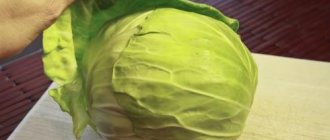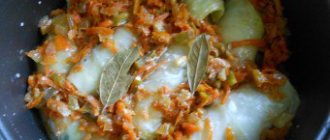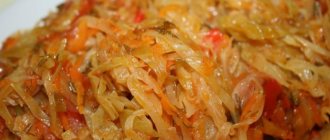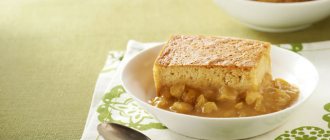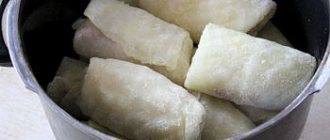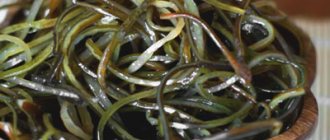Cooking a whole head of cabbage: how and how much to cook cabbage for cabbage rolls
So, the initial data:
- cabbage - 1 fork;
- pan - min. 5 liters.
The heads of cabbage that we buy in winter are no longer young. They are strong, dense and do not come apart easily. Now we will look at a method where you need to boil a whole head of cabbage for separation.
Place a large pot of water on the fire. Large enough so that it can accommodate both cabbage and water, which, by the way, should be enough to cover the forks. Turn on the heat and bring it to a boil.
Meanwhile, use a sharp knife with a sharp long blade to cut out the stalk.
When the water boils, lower the whole cabbage into the pan. Leave it there for 2 minutes and carefully remove it onto a board with a slotted spoon. Do not turn off the pan yet and do not remove it from the stove.
When you can touch the fork, remove the top leaves. They have become softer and separate well. As soon as we feel that we are starting to shoot poorly, we put the head of cabbage back into the pan.
We repeat the procedure as many times as we need leaves.
If you get more than the planned number of cabbage rolls, under no circumstances throw away the extra ones. Cool, dry a little, put in a regular plastic bag and put in the freezer. When you decide to cook cabbage rolls again, you will already have cabbage ready for them. All you need to do is take them out of the freezer, defrost them and separate them from each other.
Recipe for softening cabbage in the microwave
The method for softening cabbage for cabbage rolls in the microwave is much simpler than the standard method with boiling water. If you have a microwave oven, there is no need to specifically select soft varieties, heat a large container of water and try to wait the right time so that the leaves do not get scalded.
You can even soften young cabbage for cabbage rolls in the microwave. In boiling water, its leaves quickly boil and tear while minced meat is wrapped in them, unlike the more modern method.
A head of cabbage weighing 1.5-2 kg is suitable for preparing cabbage rolls. It can be placed directly in the oven or wrapped in cling film.
- Before you cook cabbage for cabbage rolls in the microwave, you need to peel it. The stalk can be shortened, and the upper leaves removed until they appear clean and undamaged. The leftovers can be thrown away - they will not be needed for cabbage rolls.
After removing hot cabbage from the microwave, you should immediately rinse it with cold water. This will make the leaves easier to separate from the stalk, and you can immediately wrap the minced meat in them.
Preparing cabbage for cabbage rolls in the microwave is much easier than in a pan of boiling water. The leaves soften, but remain strong and elastic.
Their flavor will be felt in the finished dish, but it will not interrupt the taste of the minced meat. In addition, this method of preparing cabbage significantly saves time.
While the cabbage is simmering in the microwave, you can quickly stuff the first leaves with minced meat. Look: stewed cabbage with potatoes and meat!
How to remove leaves from cabbage for cabbage rolls
When the cabbage is not too dense and you understand that you can separate the leaves without boiling the whole head, proceed as follows.
At the base (near the stalk) we cut the topmost leaf and remove it. Then we find the next one and cut and remove it in the same way.
In any case, the cabbage rolls removed for cooking are too hard. They will not be wrapped in the “envelope” as they should. They need to be made softer.
This is also done using boiling water. Boil water in a saucepan. Already a smaller amount than with the first method. Place the leaves in boiling water one at a time for a few seconds and remove.
Ready!
Cooking features
- Usually white cabbage is used for cabbage rolls, but sometimes Chinese cabbage is also used. The leaves of Chinese cabbage separate easily; they can also be removed from a young head of white cabbage without much difficulty. It is more difficult to separate the leaves from a mature head of cabbage, since they fit tightly to each other, but it is the late vegetable that is most often used for preparing cabbage rolls, because it is available all year round.
- The leaves from the cabbage must be removed carefully so as not to damage them, otherwise the cabbage rolls will look unappetizing and the minced meat may fall out of them. To make it easier to separate the leaves, the head of cabbage is exposed to high or, conversely, low temperatures, but there are ways to do without boiling and freezing the cabbage.
- Heat treatment allows not only to separate cabbage leaves, but also to soften them. If the leaves remain hard, they still need to be steamed or kept in boiling water for a while.
- The rough veins running inside cabbage leaves make them inelastic; wrapping minced meat in such leaves is problematic. To give them plasticity, they are beaten with the side of a kitchen hammer or the handle of a knife. You can also roll over the leaves with a rolling pin. If these manipulations do not help, the protruding parts of the veins can be cut off with a sharp knife.
- Don't overcook the cabbage. Its leaves should become soft and flexible, while still remaining dense and elastic.
How to separate cabbage leaves for cabbage rolls by freezing
If you have a lot of time on your hands. For example, you planned to cook cabbage rolls for tomorrow. You can prepare cabbage for them in a very simple way that does not require any cooking or other heat treatment. This method is freezing.
All you need to do first is cut out the stalk. Then put the cabbage in a bag and put it in the freezer for 24 hours.
After this time, we take out the forks, put it in a colander or sieve, which we place over a bowl. Let it defrost like this for several hours. It should melt completely. During melting, water will drain from it.
After which the sheets come off easily.
A couple of tips:
- Freeze either a large head of cabbage or 2 at once. Then you can freeze the extra leaves again and have a reserve for later.
- Place the cabbage in the freezer the morning of the day before cooking. Then the next evening you can cook cabbage rolls for dinner.
Easy and simple, but long.
Cabbage selection
That is why great attention should be paid to the choice of cabbage when preparing this dish. The taste qualities of the finished cabbage rolls largely depend on it.
Experienced chefs advise choosing white, Chinese and Savoy cabbage first. White cabbage of any variety is suitable for cabbage rolls. The cook can give preference to those varieties that he likes best.
But basically this dish is prepared from young cabbage leaves, from winter and medium varieties. In general, July and August white cabbage is used in most cases.
Anniversary
The “Yubileinaya” variety cabbage belongs to the mid-late variety. This plant is usually harvested in August or September. Its growing season is about 5 months.
The main distinguishing feature of this type of cabbage is the high density of heads of cabbage. Their shape is as close as possible to spherical, and their weight is about 3 kg.
The leaves of this cabbage are suitable for consumption both fresh and heat-treated. Therefore, using “Jubilee” cabbage is an excellent solution.
Odyssey F1
Quite often, cabbage of the Odyssey F1 variety is used to prepare cabbage rolls. He belongs to the mid-season. Its ripening period is only 2.5 months. The weight of one head of cabbage is about 2 kg.
The most important advantage of this variety is its ease of care. The plant resists various diseases well.
The leaves of this variety, although very thin, contain a lot of juice. This is why the taste of the dish becomes more pleasant.
How to separate cabbage leaves for cabbage rolls: steaming
To prepare cabbage for cabbage rolls, it is also steamed. How to do this, we choose depending on the size of the fork and the steamer (cooker). If forks fit in it, everything is simple.
Remove the stalk. Bring water to a boil in the bottom of a double boiler. We place the cabbage at the top. Cover the lid. Let stand for 15-20 minutes and remove.
Let it cool, take it apart and then use it to make cabbage rolls.
Now about if the cabbage does not fit into the steamer. What to do then? Take a large saucepan and boil water in it. We place a colander or sieve over the pan, into which we already place the cabbage forks. Steam for about the same amount of time.
Take your time to disassemble the steamer or structure in case the inner sheets do not come off well. We'll just put it back and hold it for another 5-10 minutes.
Warm up in the microwave
In the oven you can quickly get cabbage leaves for cabbage rolls. To do this, simply put a head of cabbage with the stalk in the microwave and turn it on at full power for 5-6 minutes. After this, the leaves will be easily removed; all that remains is to trim them at the base. If the fork is large, then the procedure should be repeated several times until all the leaves necessary for rolling the cabbage rolls are removed.
In all methods, it is desirable to remove coarse veins and leaf bases. You can beat them with a culinary hammer, but it is better to twist only the softest part of the cabbage, and use the rest to prepare cabbage.
How to cut cabbage for cabbage rolls with water
This method of preparing cabbage for cabbage rolls is cold. No water, steam or other “hot” methods. Just you, cabbage, a knife and water.
Let's go to the sink. Using a knife, cut off the very first (top) cabbage leaf at its base.
We direct a stream of water of moderate force into this cut.
Use your fingers to move the sheet away so that water flows under it through the cut.
We loosen the sheet with our fingers, the water gets deeper inside into the space between it and the rest of the fork.
And the leaf comes off completely. It takes much longer to describe this process. In fact, 2-3 seconds are enough to remove.
However, after disassembling the cabbage, before you start cooking the cabbage rolls themselves, the leaves will still have to be dipped in boiling water. Since they are fresh, they are elastic and cannot be rolled.
Filling
What kind of meat to use
Answer: any. And any bird too. And fish. And other seafood. But if the main ingredient is meat/poultry, then fat must be present. That is, the pieces of meat should have fat (pork neck, beef brisket, skin-on chicken thighs, etc.). If there is absolutely no fat in the meat itself, you need to buy it separately. This can be chicken or duck fat, lard (smoked or salted; in general, smoked meats in the filling really enliven cabbage rolls), lard, bacon, lamb tail fat. Unlike meat, it does not need to be put through a meat grinder - but simply chopped very finely. Ratio 6:1 (6 parts meat, 1 part fat). But the ratio of other ingredients is a matter of your taste, there are no rules.
Any meat, poultry, fish or seafood is suitable for cabbage rolls
What kind of cereal should I use?
Answer: any. You just need to prepare it in advance so that it is about 2/3 ready - and can still absorb the juices from the filling. The only grain that does not need to be prepared is instant couscous (that is, about all that we sell). The filling for it should be more liquid than usual, and you need to leave it to stand for 10–15 minutes - couscous absorbs even cold liquid well. Other types of cereals: rice, buckwheat (including green), millet, bulgur, spelt, barley, oatmeal, amaranth and quinoa - need to be boiled in salted boiling water or soaked for a long time in water at room temperature, also with a couple of pinches of salt. Some grains - especially oatmeal, spelt and pearl barley - are tastier and quicker to pre-fry in a dry frying pan until dark beige in color, and then cook.
Any cereal is suitable for cabbage rolls
What's going on with our vegetables?
The answer is (you guessed it): any. Everything is clear with onions and carrots, but you don’t need to limit yourself to them. You can put eggplant, zucchini/zucchini, pumpkin, sweet and hot peppers, cauliflower, broccoli, cabbage (small leaves from the same cabbage), corn kernels, celery of any kind, tomatoes and even asparagus into the filling! How delicious are cabbage rolls with meat and potatoes instead of cereal! Okay, cucumbers and radishes are not suitable - unless they are fresh (uncooked) cabbage rolls. All other vegetables should be added to the filling, cut into small cubes and fried in a small amount of oil until golden brown. The more vegetables, the juicier and more interesting the filling. The herbs can simply be finely chopped with salt and added to the filling.
You can add any vegetables to the stuffing for cabbage rolls.
To prevent the filling from being dry or hard
We have already talked about fat. If there is enough of it, the filling will not become dry. But besides fat, she needs liquid. Now you have collected the filling: meat/poultry/fish + fried vegetables + cereals + herbs + spices. Well, or some other combination options. Now add regular water. Or broth. Or cream. Or tomato sauce. Choose what suits your taste - and add a little, knead, evaluate the consistency. The filling should not spread - but it also doesn’t need to hold its shape perfectly - anyway, the cabbage leaf is responsible for the shape. If you suddenly go too far, add a little of the same cereal that is already in the filling, or raw couscous, or semolina, or crackers - but just add a little at a time, otherwise the process of liquefaction and thickening may become a loop, and this is not at all good for the filling. Or you can add finely crushed ice (or frozen broth) instead of liquid - this is a good solution.
Add plain water, broth, cream or tomato sauce to the filling
How to roll cabbage rolls?
There are only three or four options. The most common one is “envelope”. This means that you put the filling on the denser part of the sheet and wrap it in a roll about two turns. Then you fold the open edges inward and wrap it all the way. Second option: cut the cabbage leaf into 2-3 parts, roll each part into a “pound” and fill it with minced meat about two-thirds. Then carefully cover the minced meat with the free part of the sheet, as if tucking it in so that the minced meat does not fall out. These “blubs” are very convenient to eat with your hands – and you can take them with you to work or school. The third option is the simplest - simply roll the sheet with minced meat into a tube. This is usually done with thin large leaves and minced meat, which is seasoned with raw egg: it sets, gluing the filling and preventing it from escaping.
There is another cool way: a dolmer seaming machine. It was invented by the producers of a close relative of cabbage rolls - dolma - so the resulting product is very small in size, but neat and identical. All that is required is to place the prepared cabbage leaf in the desired place, straighten it, put the filling on it and roll it. Ready!
The most common option for “packaging” cabbage rolls is “envelope”

